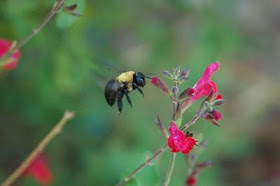Doggie Dangers Lurking in the Garden (and a completely gratuitous video of my dog responding to the clarinet and a photo).

A recent visit to the vet reminded me of the various dangers that exist for some dogs and cats in the garden. The vet had a flyer in his office called "Garden Toxins" and showed some problems for dogs (and cats) in your garden. Fall bulbs are one of these and, because we are getting into fall bulb planting season, I thought I'd write a little about this and about other potential garden hazards for your pet.
First off, I believe that the pet of an organic gardener can get into less trouble in the garden, as there are no pesticides, herbicides, fungicides (though there are some potentially harmful organic ones) and chemical fertilizers present. Second, most dogs and cats don't do a great deal of munching in the garden, though some do (in my experience, dogs and cats are more likely to much on small rodents and birds than on plants). If you have a dog that loves to eat things it found outdoors, you do need exercise some caution. Luckily, many poisons are just not palatable to dogs and cats and they are just not interested in them. In addition, many harmful plants cause vomiting and diarrhea or other short-lived symptoms, though there are some very bad things out there!
OK, so here are some cautions. Many organic fertilizers contain blood and bone meal (slaughterhouse byproducts-charming) and some dogs (include Bob Bob The Idiot Dog) find them irresistible. Bob will dig up newly planted veggies to get at this stuff. While generally not harmful in itself, these meals can be mixed with other products that are not so good for your dog.
Fall-planted bulbs- hyacinth, daffodil, tulips and autumn crocus- can be dangerous if your dog consumes them. Hyacinths and tulips can cause severe vomiting, diarrhea and drooling; daffodils can cause vomiting, diarrhea, abdominal pain and respiratory and heart rate problems; autumn crocus, the worst of the bunch, can cause severe vomiting, gastrointestinal bleeding, liver and kidney damage and can send your dog into shock. So, when you are planting these bulbs, do not leave them out where your pet can get hold of them and eat them and monitor your recently planted bulb beds for digging. Throw any bad bulbs away in the trash or compost them where your pet cannot reach.
For you southern gardeners, a small amount of oleander can kill a pet-or a child. The toxins leach out from the flowers and plant and even a few seeds can kill. It causes severe vomiting, abnormal heart rate, shock and weakness, leading to death. If you suspect your pet has eaten oleander call a animal poison control center or your 24 hour vet immediately! If you have a pet or small child, it might be best to rid your yard of this lovely, but dangerous, plant. Another southern plant that is a problem with similar symptoms (and also severe liver failure) is the sago palm.
Asiatic lilies are highly toxic to cats, and cause severe kidney failure. Azalea can cause vomiting, diarrhea, drooling and death as well (I have never seen a dog show the slightest interest in azalea, but...)
The petpoisonhelpline.com has a complete list of pet poisons. They have a call in line (I remember being surprised that there was a $35 charge for a pet poison center call, but you need to pay for this professional advice). Some universities have pet poison information. It might be useful to keep the number handy, just in case.
[One last note- some people poison mice, moles and voles to get them out of the yard and garden. This can be a big problem if your dog, like mine, loves to snack on furry critters- they will ingest these deadly poisons too and might die. Also, poisons are surprisingly ineffective on voles and moles. Dogs who dig their tunnels, like mine, may encounter the poison. Not to mention cats, and birds of prey who may pick up a dying rodent and consume it].
Happy and safe gardening!





